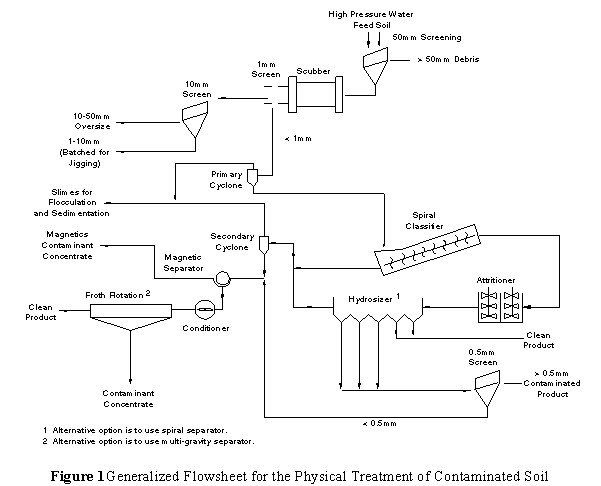
(formerly WARREN SPRING LABORATORY)
(Soil Separation and Washing Process)
The National Environmental Technology Centre of AEA Technology has developed an ex situ soil separation and washing process that uses mineral processing technology and hardware. The process can be used (1) as a volume reduction process to release clean soil fractions and concentrate contaminants, or (2) as a pretreatment stage in a treatment train.
Because each contaminated soil is different, AEA Technology has developed a custom physical treatment process for soil using a three-stage process: laboratory-scale characterization, separation testing and assessment, and treatment and data analysis.
AEA Technology is experienced in conducting pilot plant testing programs on contaminated land and mineral ores. In addition, AEA Technology uses computer software designed to reconcile material flow data. The results from data processing lead to recommendations for full-scale continuous flow sheets with predicted flows of solids, associated contaminant species, and water. Also, estimates of the contaminant levels and distributions to the various products are estimated. This data is required to estimate the cost and potential for success of the full-scale remediation process plant. Flow sheet configuration is flexible and customized to the nature and contamination of each soil or waste.
A typical schematic flow sheet of the process is shown in the diagram below. The flow sheet involves screening the raw feed at 50 millimeters (mm) under powerful water jets to deagglomerate the mass. Debris less than 50 mm in size is often decontaminated. Remaining solids and the water pass through a grinding mill acting as a drum scrubber. The grinding mill is more violent than the screen, further separating the soil mass. It breaks down clay lumps and adhering material into suspension, except for surface coatings of clay and oil on fine particles. The mill discharge is screened at 1 mm and the oversized discharge is screened from 1 to 10 mm. The mill discharge from 10 to 50 mm is often clean debris; if it is not clean, it can be crushed and refed into the system. Material from 1 to 10 mm is usually still contaminated and requires further treatment.

The clay and water are removed from the suspension containing particles greater than 1 mm. The fine product, less than 10 micron (m), is flocculated and thickened to reclaim the process water for recycle. Thickened clay product, usually containing concentrated contaminants, passes to further treatment or disposal. Sands from the hydrocycloning step are further dewatered in a classifier before the third and most intense deagglomeration operation.
An attrition scrubber removes the remaining surface contamination, as well as pulps and clayballs. Having completed deagglomeration, the soil is fractionated by particle size or separated by specific gravity. A second stream of particles less than 10 m is removed by hydrocycloning and joins the primary product stream. Finer sands and silt are screened at 500 m to yield a contaminated sand for disposal or retreatment. A 10- to 500-m fraction can be separated magnetically, by flotation, multigravity separation, or a combination. These stages produce a contaminant concentrate leaving the remaining material relatively contaminant free.
The soil separation and washing process is designed to remove metals, petroleum hydrocarbons, and polynuclear aromatic hydrocarbons from soil. The process may be applied to soils from gas and coke works, petrochemical plants, coal mines, iron and steel works, foundries, and nonferrous smelting, refining and finishing sites. The process can also treat sediments, dredgings, sludges, mine tailings, and certain industrial wastes.
The technology was accepted into the SITE Emerging Technology Program in July 1991. For this project, soils from three sites were characterized in the laboratory. One soil, from a gasworks, was then selected for treatment in a pilot-scale unit.
Pilot trials were conducted on 30 tons of soil at a throughput rate of 0.5 ton per hour. Several test runs were performed to evaluate different flow sheet configurations. Results from this test will be available in late 1996.
TECHNOLOGY DEVELOPER CONTACT:
Steve Barber
AEA Technology PLC,
National Environmental Technology Centre
Culham, Abingdon
Oxfordshire OX14 3DB England
011-44-1235-463062
Fax: 011-44-1235-463010